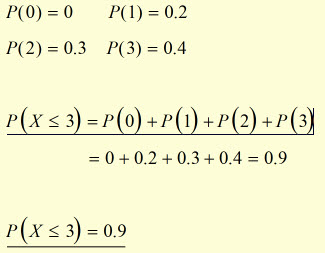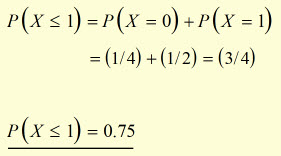Home >>STATISTICS, Section 1, discrete random variables 1
Concept
The basic idea is assign a real number xr to every event Er happening in the sample space S .
Example
Consider the case when a coin is tossed twice. The possible results( the Sample Space S) are:
(T T) (T H) (H T) (H H)
Assigning numbers for the number of 'heads' (H) occuring:
(0) (1) (1) (2)
So overall, there are 3 possible outcomes:
no heads one head two heads
This can be written as the result:
0 1 2
So the probability of flipping a coin twice and obtaining a head is given by:
no. of heads
|
sample space S
|
probability
|
0 |
(T T) (T H) (H T) (H H) |
1/4 |
1 |
(T T) (T H) (H T) (H H)
|
1/2 |
2 |
(T T) (T H) (H T) (H H)
|
1/4 |
The Probability (Density) Function PDF
The probability function of X, written as P(X=x), is used to allocate probabilities.
We describe X as a discrete random variable, when it has a finite number of possible values and if the sum of probabilities is one.
X takes the value xr when the event Er occurs.
From our example(above) it is self evident that:
event E = 1 one head x = 1 P(X=1) = 1/2
So all the results in our example could be displayed as:
| event E | x |
sample space S |
P(X=x) |
0 |
0 |
(T T) (T H) (H T) (H H) |
1/4 |
1 |
1 |
(T T) (T H) (H T) (H H)
|
1/2 |
2 |
2 |
(T T) (T H) (H T) (H H)
|
1/4 |
The probability function can also be written as p(x) .
therefore,
P(X=x) = p(x)
Cumulative Distribution Function CDF

This function returns the sum of probabilities of X for values of x less than or equal to x0 .
It also may be described as the function F(x0) giving the probability of X when its value is less than or equal to x0 .
A more general definition is that cumulative probability F(x0) is the value a random variable takes when it falls between a specific range.
Example #1
Consider a situation where there are four possible outcomes(x = 0, 1, 2, 3 ), with different probabilities for each of these.
The probability that X is less than or equal to 3 is given by:

Example #2 (with reference to the coin flip table above)
A coin is flipped twice. What is the probability that '1' head or '0' heads result?

All the results for heads(x) from 2 coin flips can be summarized in a modified table:
E |
x |
P(X=x) |
P(X<x) |
|
0 |
0 |
(T T) (T H) (H T) (H H) |
1/4 |
1/4 |
1 |
1 |
(T T) (T H) (H T) (H H)
|
1/2 |
3/4 |
2 |
2 |
(T T) (T H) (H T) (H H)
|
1/4 |
1 |
Notice how P(X<x) is derived from P(X=x) when x is incremented.
this week's promoted video
[ About ] [ FAQ ] [ Links ] [ Terms & Conditions ] [ Privacy ] [ Site Map ] [ Contact ]
